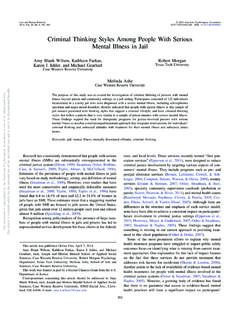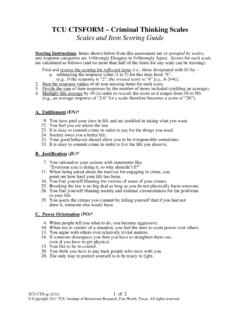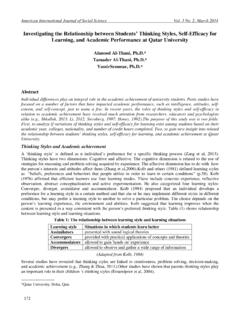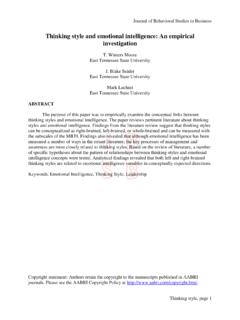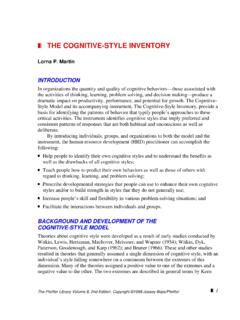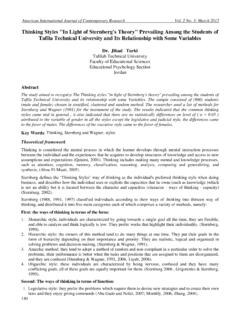Transcription of DISCOVERING AND DEVELOPING THINKING STYLES IN …
1 1 DISCOVERING AND DEVELOPING THINKING STYLES IN BUSINESS STUDENTS by Introduction Just as different vocational fields require proficiencies in different academic disciplines, so do they require unique intellectual proficiencies or THINKING STYLES . For example, success in some fields requires that individuals apply rules or critique arguments and procedures, whereas success in others demands that individuals draft new rules or imagine arguments and operating procedures.
2 Thus, while 2 individuals may possess the same content knowledge and level of intelligence, the preferred THINKING style of one may better suit her to a particular type of job, , one that is consistent with her THINKING style. Consequently, it is important for educators to both hone the THINKING STYLES exemplified in certain fields and to value them in our instruction and assessment methodologies. As noted below, the legislativei or creative THINKING style is among the most critical to business leaders and upper management success.
3 Consequently, 193 business students were studied to determine their preferred THINKING style: Specifically, whether business students exhibited the legislative THINKING style. Results suggest that, not only, do students not prefer the legislative style, but that they favor its very opposite. After considering reasons for and ramifications of this apparent stylistic disconnect between THINKING style and future career, it is proposed that instructors reconfigure course elements and assessments to develop in students the legislative THINKING style.
4 A number of models and examples translating traditional and/ or executive assessments to legislative ones are included to ease instructors into this process. Indeed, as is apparent from the examples provided, broadening one s instructional repertoire to include a focus on legislative THINKING is relatively simple and enhances the educational outcomes of all students. THINKING Style Many theories and definitions of THINKING stylesii and preferences Some are grounded in physiological differences of the brain,iv others are personality-based,v and still others focus on the reinforcement of preferences toward Though all delineate STYLES differently,vii all agree that a THINKING style or preference is the way in which individuals absorb, interpret, and evaluate Whether learned or innate.
5 Ix style does not correlate with level of intelligencex or ability. Rather, it reflects a propensity or preference to use, conceive of, or express information in certain Thus, one may enjoy creating, but find that the fruits of her efforts are not very good, , the painter who loves easel and brush, but whose paintings fail to rival those of a blind 4 year old; the singer who does not seem as inspired by the Sirens as by a cat in heat. Nevertheless, though such preferences are not correlated with intelligence, they are influenced, synergistically or detrimentally, by environment.
6 Where a person must perform tasks or think in ways consistent with their style, they will excel; where that person must work against or outside of style, the tasks may appear more challenging, and their ultimate level of performance For instance, some ways of THINKING or manipulating information are valued more highly in schools and business than Where an employee s stylistic preference matches the tasks for which she is responsible or role in which she inhabits, she will perform those tasks more easily or more consistently with expectations.
7 Where a student s stylistic preference matches the way in which she is taught and the way in which she is assessed, she will both learn material and perform her understanding of that materially more easily (or more consistent with the expectations of the instructor). A match between stylistic preference and required performance 2will typically lead to the most favorable (highest level of performance). Conversely, where there exists a mismatch, performance will Therefore, the result, as impacted by THINKING style, may sometimes be confused with intelligence or ability.
8 In academia, THINKING STYLES are relevant to a student s response to instruction and performance on assessment A positive correlation between THINKING style and assessment style or between THINKING style and teaching style will beget a more positive assessment or higher grade. Simply, where a learner is taught in a way consistent with her learning style, she will avoid hurdles erected as a result of translating out of a non-preferred style and into her own, but, rather, will learn in the best possible environment.
9 Where that learner is assessed in a way consistent with her style, she will have the best opportunity to perform to the best of her ability. Accordingly, differential academic success may result in part from different ways of THINKING and learning or differing levels of intelligence (however defined).xvi Where success is influenced by the former variable, learning style theory is implicated. Unfortunately, little research has been done on preferences for knowledge acquisition environments.
10 Xvii Establishing a better understanding of learning and testing pretences is important in designing methods of instruction and Sternberg s Stylistic Types One of the most renowned learning style theorists is Robert Blending his expertise in psychology with that in educational theory, Sternberg proposes a broadened notion of This triarchic theory of mental self-government accounts for different methods of THINKING and Central to Sternberg s triarchic theory is its proposition that there are three ways or STYLES of organizing one s THINKING : an executive style, a legislative style, and a judicial This theory is particularly helpful in understanding how business students learn and later translate knowledge to the workplace.
